Walking the Caminito del Rey near Malaga should be on any Andalucian bucket list.
Once regarded as one of the most dangerous hikes in the world, the Caminito del Rey underwent repairs between 2009 and 2015 and is now a dramatic walk through towering gorges with walkways pinned against the sheer cliff faces.


It can be confusing when researching the various ways of walking the Caminito del Rey so this post gives you all the essential information you need to ensure you have the trip of a lifetime, including how to buy tickets, the best way to get there and, of course, what it’s actually like to walk what was once known as the Walkway of Death!
This post may contain affiliate links which means if you click a link and purchase something that I have recommended I may receive a commission. While clicking these links won’t cost you any money, it will help to keep this site going. Thank you for your support.
The history of the Caminito del Rey
The Caminito del Rey, or King’s Little Pathway, was built between 1901 and 1905 to allow access for the workers at the El Chorro hydroelectric power station and to enable them to transport materials between two power plants.
However, it didn’t get its name until 1921 when the dam was finished and it was officially opened by King Alfonso XIII.
The original pathway was constructed from concrete and steel, was just 3 feet wide and offered very little in the way of protection for anyone walking it. Workers building the pathway would hang from ropes secured to the top of the gorge so it almost seems unbelievable that only two men died during construction.
Once the official use for the walkway was over, the pathway fell into disrepair over the years and was finally closed down in 2000.
In 2009 work began on renovating the walkway and, following a significant cash injection from the Malaga and Andalucia governments, the new and improved Caminito del Rey was open to the public in 2015.
Now it’s one of the top things to do in Andalucia, if not the whole of Spain, and since its reopening more than 2.5 million people have walked the Caminito del Rey.
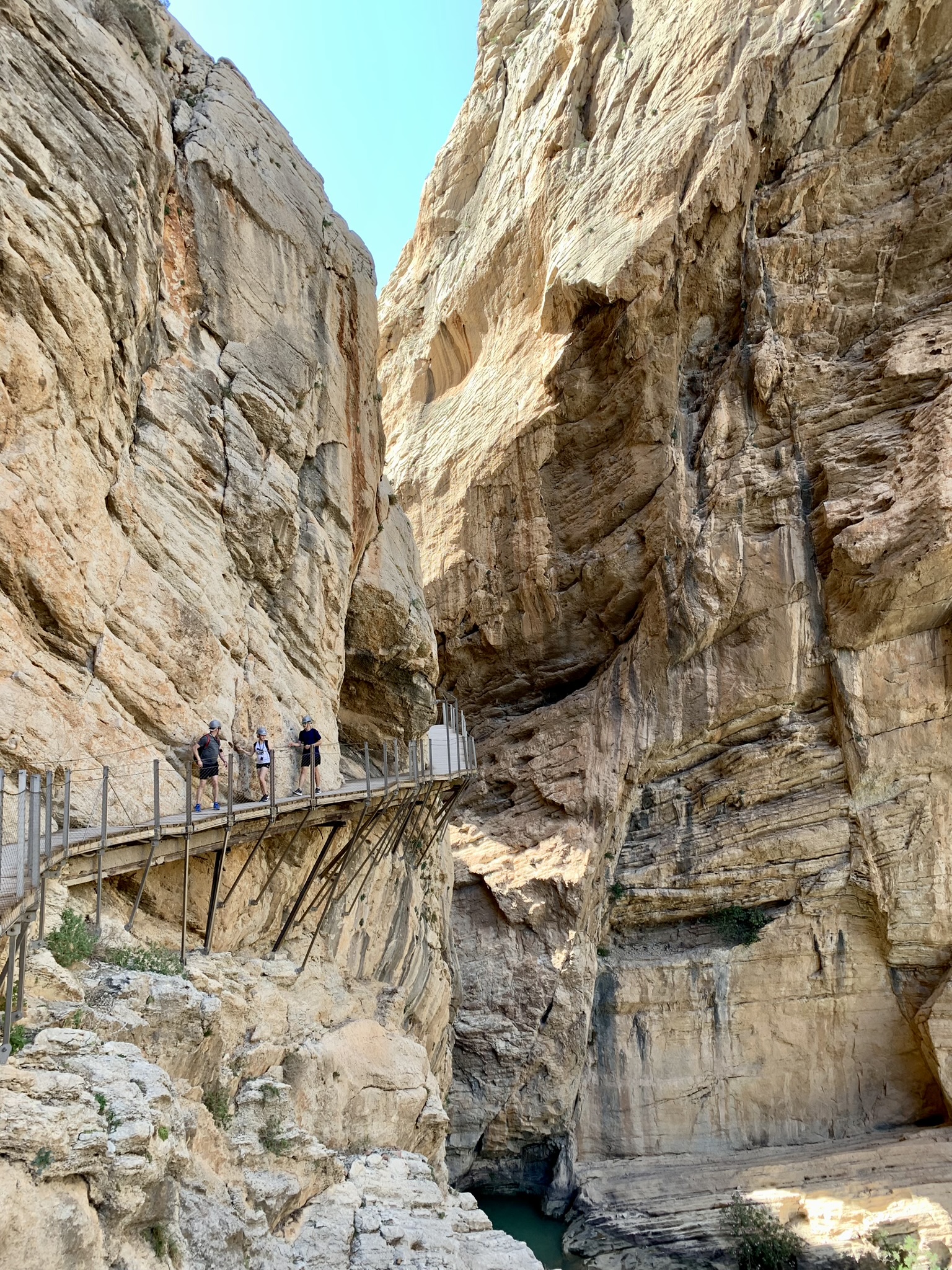

Is it safe to walk the Caminito del Rey?
After its original use was made redundant, the Caminito del Rey was left to its own devices and, thanks to lack of maintenance coupled with landslides and rockfalls, the pathway fell into disrepair. However, that didn’t stop adrenaline junkies attempting to walk the route despite the now precarious state of the pathway and, over the years, there were a number of deaths and accidents.
The last fatalities occurred in 1999 and 2000, at which point the government closed both entrances.
However, thanks to the extensive improvements the Caminito del Rey has shaken off its reputation as the world’s most dangerous hike and is now a safe and easy walk, with no accidents reported, that can be enjoyed by anyone with average fitness levels – and even those with a fear of heights. More on that later!


Repairs and renovations included a brand-new walkway over the original concrete and steel path (you can still see the original path on parts of the walk) with reinforced railings and iron mesh. In addition, visitor numbers are capped at 1,100 per day and safety helmets are required (these are handed out to all walkers at the trail entrance).
Tickets for the Caminito del Rey
You must have a ticket to walk the Caminito del Rey but, be warned, they do sell out very quickly so if you’re planning a holiday to Andalucia and intend to do this walk then make sure you book your ticket as soon as possible. However, you need to be aware that tickets are only released in batches throughout the year which means you can’t book too far in advance.
Booking tickets is easy via the official Caminito del Rey website and you’ll have a choice of buying either general tickets or official guided visit tickets.
General Tickets (€10 per person)
With a general ticket you can complete the walk in your own time. Although you have a timed entrance, and must be at the official entrance gate at the time shown on your ticket, there’s no limit for how long you can stay along the route.
Official Guided Visit Tickets (€18 per person)
If you book a guided visit ticket you’ll be part of a small group (maximum of 30 people) and will be led by a certified guide through the gorge. Guided visits are in either Spanish or English (you’ll be put in the correct group when you arrive at the entrance gate).
The general admission tickets are cheaper but they do tend to sell out much quicker than the guided walks.
The advantage of the guided walks is that you get a lot of information about the Caminito del Rey and its history but the drawback is that you’re with a group of other walkers so you can’t really linger to any great extent.
However, we walked with a guide and I don’t feel that we were rushed. In fact, at various points when our guide was explaining certain things to us we were overtaken many times by walkers with general tickets.


Whichever option you choose, you have to create an account on the website before purchasing and, once your booking has been confirmed, you have to input the personal details of each ticket holder before downloading or printing your tickets.
All prices are correct at the time of writing (July 2023).
Tickets are sold in timed slots throughout the day with a cap on the number of people who are permitted to walk in each slot and it’s worth noting that, if you buy a ticket and are subsequently unable to visit on your selected date/time there are no refunds and you can’t choose an alternative date.
Guided tours to the Caminito del Rey
If you find that there are no tickets for sale on the official website on the day you want to go I’d suggest looking at websites such as Get Your Guide or Viator as they often have tickets available.
They also offer fully guided tours which include transport from Malaga and other Andalucian cities.
Getting to the Caminito del Rey
The Caminito del Rey is a linear route that starts in Ardales and finishes in El Chorro so, at some point, either before or after the walk, you’ll need to jump on one of the regular shuttle buses that run between the start and end points of the trail. I’ll explain more about that later.
By car
If you’re coming by car you’ve got a choice of three parking spots – at the northern entrance to the Caminito del Rey near the start of the walk, in El Chorro at the end of the walk, or at the Visitor’s Centre, which is roughly halfway between both points.
It’s €2 per day to park at any of these locations. If you pay on arrival it’s cash only but you can reserve a parking space and pay at the same time as booking your tickets.
Northern Entrance (near El Kiosko restaurant)
This is probably the easiest option as it means you’re almost at the start of the walk and can simply get the shuttle bus at the end back to your car.
Visitor’s Centre
This is roughly halfway so you’ll need to jump on the shuttle bus to get to the start, and again at the end to return to your car.
However, if you’re interested in visiting the centre to find out more about the history of the Caminito del Rey this would be a good choice.
El Chorro
If you’ve got plenty of time before your allocated time to walk, you could park in El Chorro, take the shuttle bus to the start and then simply pick up your car again as soon as you’ve finished walking.




By train
There are regular trains each day which leave from Estacion Maria Zambrano in Malaga to El Chorro.
We opted to travel by train, which is one of my favourite ways of getting around Spain. The journey takes around 45 minutes and costs €3.50 one way. Travelling by train means that you can sit back, relax and enjoy the stunning scenery.
You can check all departures on the Renfe website.
From the railway station you’ll need to take the shuttle bus to the start of the trail. El Chorro is very small and you’ll spot the shuttle as soon as you leave the station.
By bus
You can also get to the Caminito del Rey by bus but, if you’re coming from Malaga you’ll need to change at Alora to get to El Chorro, so it’s not the best option if you have limited time.
Shuttle bus
The shuttle bus which runs between El Chorro, the Visitor’s Centre and El Kiosko takes around 20 minutes and runs every 30 minutes (on the hour and half hour).
During the summer months it runs from 8.30am until 6pm, and in winter from 8.30am until 5pm.
The tickets cost €2.50 per person and you can buy them at the small kiosk outside the railway station or pay on board (cash only). However, you also have the option to buy them when booking your tickets for walking the Caminito del Rey.
Now to the important bit – what is walking the Caminito del Rey actually like?
Walking the Caminito del Rey
As I mentioned earlier, it’s a linear route and there are three distinct stages of the Caminito del Rey walk – the trail to the start of the pathway, the walk through the gorge, and the exit to El Chorro village.
Stage One – El Kiosko to the Caminito del Rey Official Entrance Gate
The shuttle bus stops at the parking lot near the El Kiosko restaurant and from here there’s a choice of two paths to reach the official entrance gate.
The pedestrian tunnel, which is 200m up the road from El Kiosko, takes around 20 minutes to walk (1.5 kms), while the Gaitanejo trail, which is right next to the restaurant takes around 50 minutes to walk (2.7 kms). Whichever route you take they eventually merge close to the official entrance gate.
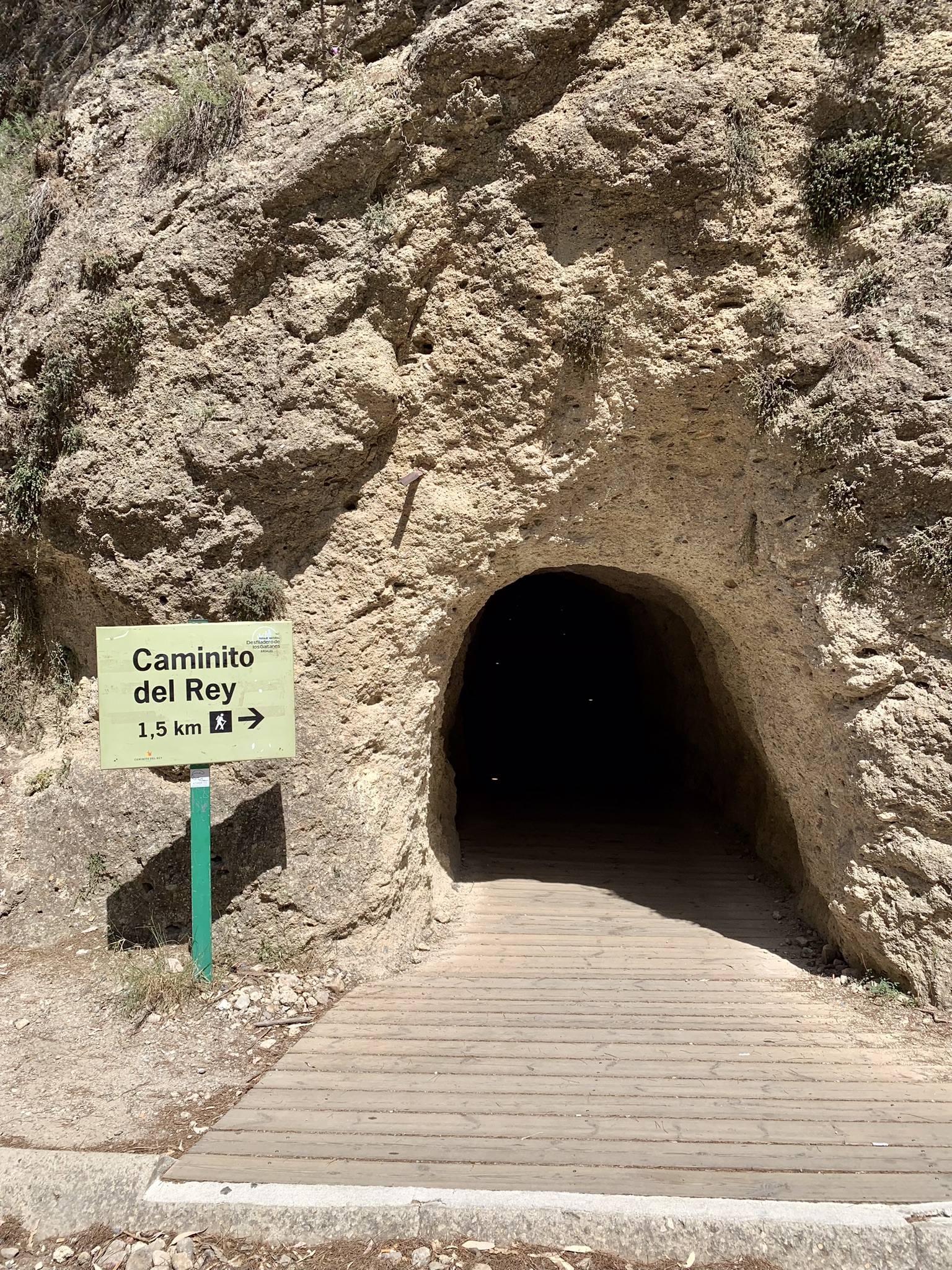

We took the shorter route through the pedestrian tunnel. The actual tunnel part is fairly short and there are lights on the floor so it’s not too dark.
Once we came out of the tunnel we followed the path, which was well signposted, and walked through some beautiful mountain landscapes until we reached the official entrance.


Stage Two – El Caminito del Rey
As picturesque as the walk to the official entrance gate was, stage two is what we were all here for. This is the official section where the path heads through the narrow gorges on walkways suspended on the cliff face.
Be aware of the time on our ticket as that’s your starting time. It’s worth getting there at least fifteen minutes early so that you have time to collect your helmet and, if you haven’t done so before, use the toilet. The ones at the entrance are the last ones until you reach the end. There are also some vending machines near the control cabin for the last-minute purchase of any water you might need. Make sure you have plenty of water with you, particularly if you’re walking during the summer months.
We arrived early and joined a group of other walkers who had also booked a guided visit.
We were then split into two groups – one for Spanish speakers and one for those taking the tour with an English-speaking guide. We were given hairnets, helmets (grey if you’re on a guided visit, and blue if you’re walking under your own steam), radios (which we wore on lanyards round our necks) and earphones and, after making sure that everything was securely in place and we could hear our guide through the earphones, we were ready to go.
Our guide gave us a short safety briefing and then we were off.
Now, I’m not a great fan of heights so while part of me was really looking forward to finally walking the Caminito del Rey, another (much bigger) part was absolutely dreading it.
The walk down from the control cabin passes the old hydroelectric substation and a dam and, at this point, is just like any other walk in the great Andalucian outdoors – blue skies, beautiful scenery, and the occasional glimpse of vultures flying overhead.


After passing an information board about the history of the Caminito del Rey, there it was – the first section of the boardwalk pinned to the walls of the Gaitanejo gorge. Deep breaths, this was it, the moment of truth!
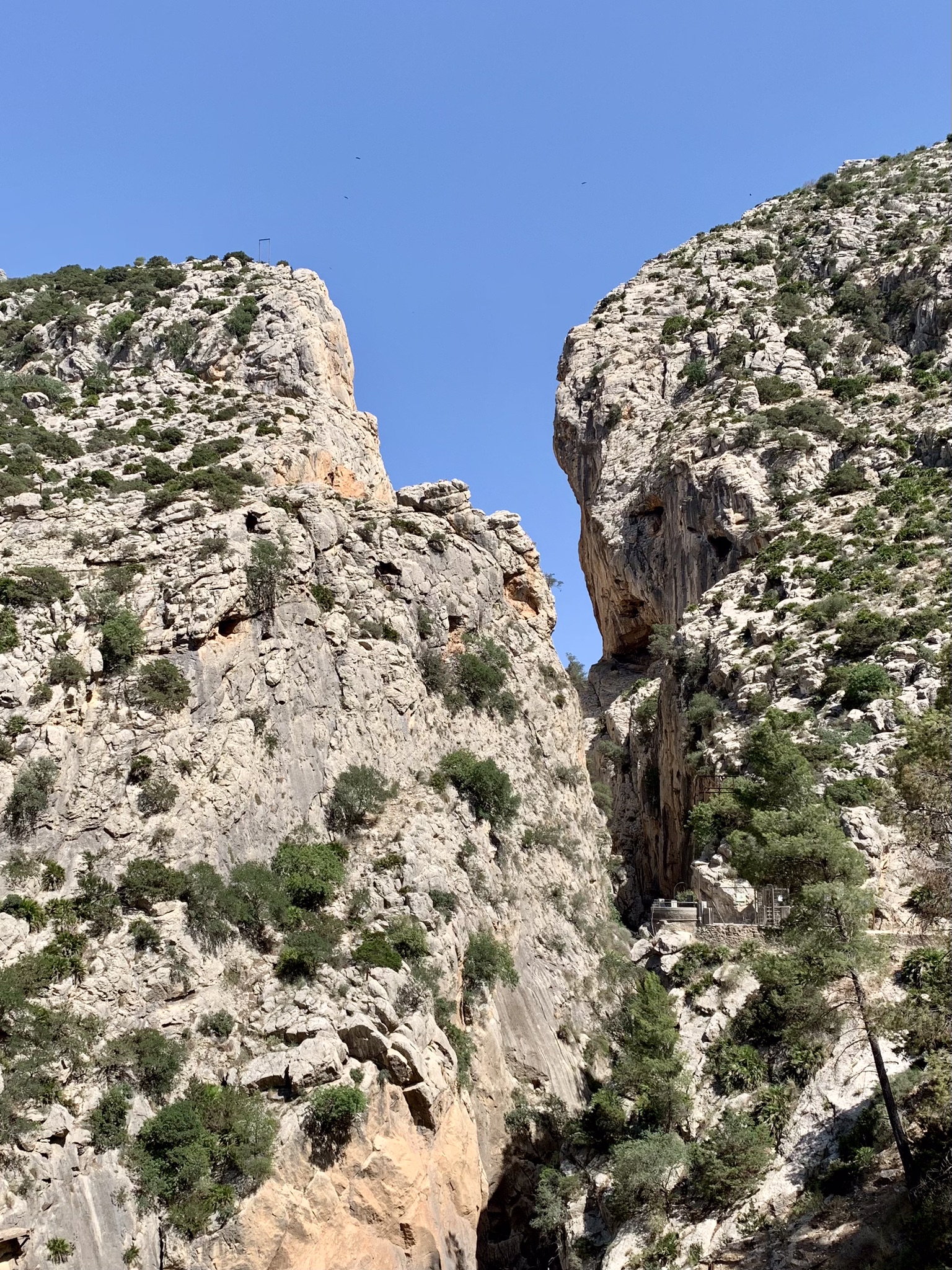

The wooden pathway is secured by steel rods pinned into the cliff face and a mesh fence keeps you secure. I’ll be honest, I didn’t let go of the handrail unless I absolutely had to and I only looked down when the wooden slats were above the original pathway but, as long as I couldn’t see the bottom of the gorge beneath me, I was fine. The fact that there are big stretches where there’s nothing between the new wooden walkway and the ground below gives you some idea of just how much disrepair the original path had fallen into.


In parts, the Gaitanejo gorge is less than 10 metres wide and at various points along the pathway our guide would stop to point out things of particular note. What I particularly liked about the fact that the guides use radios and earphones is that you don’t have to constantly keep up with them to be able to hear what they’re saying so I was able to linger and take photos without feeling that I was missing out on any important information.
Don’t forget to turn around at times to get photos of the walkway curving around the cliffs.


Leaving the wooden boardwalks behind for now we reached an area called El Soto, which is a small pond between the two gorges. The path here is known as the Butter Stairs (or Chocolate Stairs depending on which guide you have). These are concrete steps in a wave formation which were designed that way to make it easier for donkeys to carry heavy loads up and down them.


Passing through a small tunnel in the cliff face, El Lugar del Soto, you reach the second canyon, El Tajo de las Palomas, where the area opens up into El Valle del Hoyo.
Here you can see the Puente del Rey, so named because it was crossed by Alfonso XIII when he officially opened the Caminito del Rey. The original use for the bridge was to connect both sides of the valley and help with the loading and unloading of construction materials.


Walking through the valley our guide chatted to us about various points of interest, including information about the flora and fauna of the area before we reached the Sapito Pintojo pond at the lowest part of the Caminito del Rey. Here there are benches where you can sit in the shade, enjoy the silence and, if you’re lucky, spot some wildlife. We were there in June which meant there wasn’t a great deal of water in the pond, but we did spot some Iberian ibex foraging in the shrubs.


We were now getting close to the Gaitanes gorge where, just before the boardwalks start again, there’s a bat shelter. This has been built in an old service tunnel and, as there are several threatened species of bat in the area, the shelter was constructed to help with their hibernation.
At this point, the walk would normally resume on the suspended boardwalks into the Gaitanes gorge. However, on the day we walked it was pretty windy so the decision had been made to close this section of the walk and, instead, we took the tunnel behind the cliff face.


This tunnel was restored and reopened in 2017 and means that, on wet or windy days, or when there has been a rockfall, the Caminito del Rey can stay open without visitors needing to retrace their steps.
There is low level lighting throughout the tunnel and, at various points throughout, there are holes which enable walkers to see through to the gorge.
At one point we had an excellent view of the original path and just what a state of disrepair it was in.




While part of me was disappointed not to be walking on the boardwalk through the Gaitanes gorge, as it’s widely recognised as the most breathtaking part of the trail, safety obviously comes first and it does mean I have a good excuse to come back and walk again one day!
Taking this route meant that we missed out on several sights including a juniper tree growing among the rocks which is over 100 years old, as well as a huge fossil on the wall.
It also means we missed the glass balcony which, as you would expect, is a glass viewing platform which juts out over the gorge. I have to admit, I was less bothered about missing this – there’s no way I would have ventured on to that for a bird’s eye view of the gorge!
Reaching the end of the tunnel we came to the part of the walk that I had been dreading – the hanging bridge.
Stretching across the gorge from one side to the other, the bridge is suspended more than 100 metres across the floor of the gorge and, thanks to a metal grid base means you can enjoy (or otherwise) the view down into the abyss.


Only ten people at any one time are allowed on the bridge, which is carefully monitored by a guide, although it has been safety tested to hold up to 50,000 kgs in weight.
Despite my fear of heights I’d been fine for most of the walk but at this point the fear really kicked in and I’m thankful that the guide who was monitoring access to the bridge was there. While other people lingered on the bridge looking around and taking photos, he chatted to me and then, when the bridge was empty, he walked backwards across it, talking to me all the time to keep my mind off where I was while I kept my eyes looking firmly ahead, my hands never leaving the railings! My hero!!
There was some more boardwalk with steps (they’re steep and pretty narrow so you need to keep your wits about you) before we reached solid ground again and the final stretch of the walk. Apart from the bridge, this was my least favourite part of the walk as I could see directly between the wooden slats to the ground below.
Make sure you turn around at this point and you’ll notice just how small the path looks pinned against the huge cliff face.


Stage Three – El Caminito del Rey exit to El Chorro
The path from here is a pleasant walk back to El Chorro. Along the way there are information boards about the building of the Caminito del Rey and the road passes the Los Albercones viaduct also known as Puente de la Josefina.


There’s also an old chapel school, Ermita de la Medalla de la Milagrosa. You’ll notice, if you decide to walk up for a closer look, that it’s reached by more ‘butter stairs’.
The chapel school was built for the children of those who worked on the construction of the Caminito del Rey.


Finally, you’ll reach the end of the route where you’ll return your helmet. At this point there are a number of kiosks selling food and drink, as well as a large picnic area set up with benches, and tables and chairs.
Although it’s only a short walk from here to get to the shuttle bus it’s uphill so you might want to stop for a drink and a snack and reflect on the journey you’ve just taken.




What else is there to see near the Caminito del Rey?
If you’re staying for a night or two in El Chorro you’ll have the chance to do some more hiking in the hills around the village.
Two long distance routes pass through this area – Stage 21 (El Chorro to Ardales) of the Gran Senda de Malaga (GR-249), and Stage 1 (El Chorro to Alora) of the Gran Senda del Guadalhorce (GR-248).


If you fancy something more relaxing you could get the shuttle bus to the lake at the northern entrance of the Caminito del Rey and spend the day by the water.


Where to stay
Although you can easily walk the Caminito del Rey on a day trip from Malaga and the Costa del Sol, Granada or Seville, I’d recommend staying overnight if you can.
There’s a variety of accommodation in El Chorro itself to suit all budgets as well as further afield in Ardales or Alora.
We stayed at Complejo Turistico La Garganta, a converted flour mill with a prime location on the edge of the Embalse Tajo de la Encantada, choosing a room that had excellent views of the water.




The hotel is just across the road from the railway station at El Chorro if you’re arriving by train, but also offers free parking if you choose to drive.
Frequently Asked Questions about walking the Caminito del Rey
What are the opening hours of the Caminito del Rey?
The Caminito del Rey is open Tuesday to Sunday from 9am to 5.20pm (summer months) and 9am to 3.30pm (winter months).
It is closed on Mondays, as well as on December 24th, 25th and 31st, and on January 1st.
The Caminito del Rey does occasionally close due to maintenance or unforeseen weather conditions (which includes high temperatures as well as wind and rain). If that happens on a day when you’re due to walk you can select an alternative date by logging into the personal area you created when buying your tickets.
How much does it cost?
The cost depends on the type of ticket you buy. Self-guided tickets are €10 and guided visit tickets cost €18 per person.
How far is the Caminito del Rey?
The Caminito del Rey is a linear walk of approximately 7.7 kms. Thanks to the cap on daily visitor numbers it never felt particularly busy or crowded on the walk.
How long does it take to walk?
From start to finish it took us around 3 hours to walk the Caminito del Rey with a guide. Without a guide you could do it quicker (we were frequently overtaken by walkers without a guide), but it would be a shame to rush it. Alternatively, without a guide you could linger in the shaded area in Valle del Hoyo.
How difficult is it?
Although there are some uphill sections as well as some steps, particularly at the end, it’s not overly physically demanding. However, if you don’t like heights then you’ll be challenged in other ways!


When is the best time for walking the Caminito del Rey?
You can walk the Caminito del Rey year-round, but spring and autumn are probably the most comfortable times in terms of the weather, and both are wonderful seasons to be in Andalucia.
If you have no choice but to walk during the hot summer months of July and August then make sure that you take plenty of water with you (much more than you think you’ll need) and, if you can, book one of the early morning slots so that you’ll have finished well before the heat of the day.
The day after we walked, we were enjoying a drink and a bite to eat at one of the kiosks at the end of the route and we saw so many walkers passing us who looked ready to drop thanks to the midday heat.
Is the Caminito del Rey suitable for children?
Yes, but only children who are over eight years old are permitted to walk the Caminito del Rey and they must be accompanied by an adult, and supervised at all times. It should be obvious but it’s worth noting that, for safety reasons, children can’t be carried at any point during the walk, particularly when on the walkway. If you do plan to walk with children, make sure you bring their passport so that their age can be verified at the start of the walk.
What should you take with you when walking the Caminito del Rey?
There are a few important items to consider before you start to walk the Caminito del Rey.
Footwear. Shoes need to have a good grip and must have closed toes. As you’ll be walking for several hours over various terrains your footwear also needs to be comfortable. Note that your footwear will be checked at the entrance to make sure that it’s suitable.
Water and snacks. Even though it’s a straightforward hike there are no water sources so make sure you have a good supply of water with you. I have a couple of Chilly’s bottles which keep water cold for 24 hours (ideal in the heat of Andalucia). I also have a backpack with a water bladder insert which I use for longer hikes and which would be perfect for walking the Caminito del Rey.
You can also take a small supply of food so pack a few energy bars or some fruit in your backpack.
Sunscreen. Andalucia has over 300 days of sunshine a year so always wear a sunscreen with a high SPF, even if you’re walking during the winter months, and bear in mind that there’s very little shade on the hike.
Warm clothing. Depending on the time of year and/or day you walk, it may be worth putting a hoodie or light jacket in your backpack. If you’re walking in winter you might also want to consider a waterproof jacket.
Phone and/or camera. No explanation needed for this one – the scenery is spectacular and you’ll definitely want to capture it on film. Note that selfie sticks aren’t allowed on the walk. If you’ve got one with you you’ll be asked to put it in your backpack for the duration of the walk.
Hat and sunglasses. The sun is strong in Andalucia and in the absence of much shade on the walk you definitely need something to protect your head and eyes.
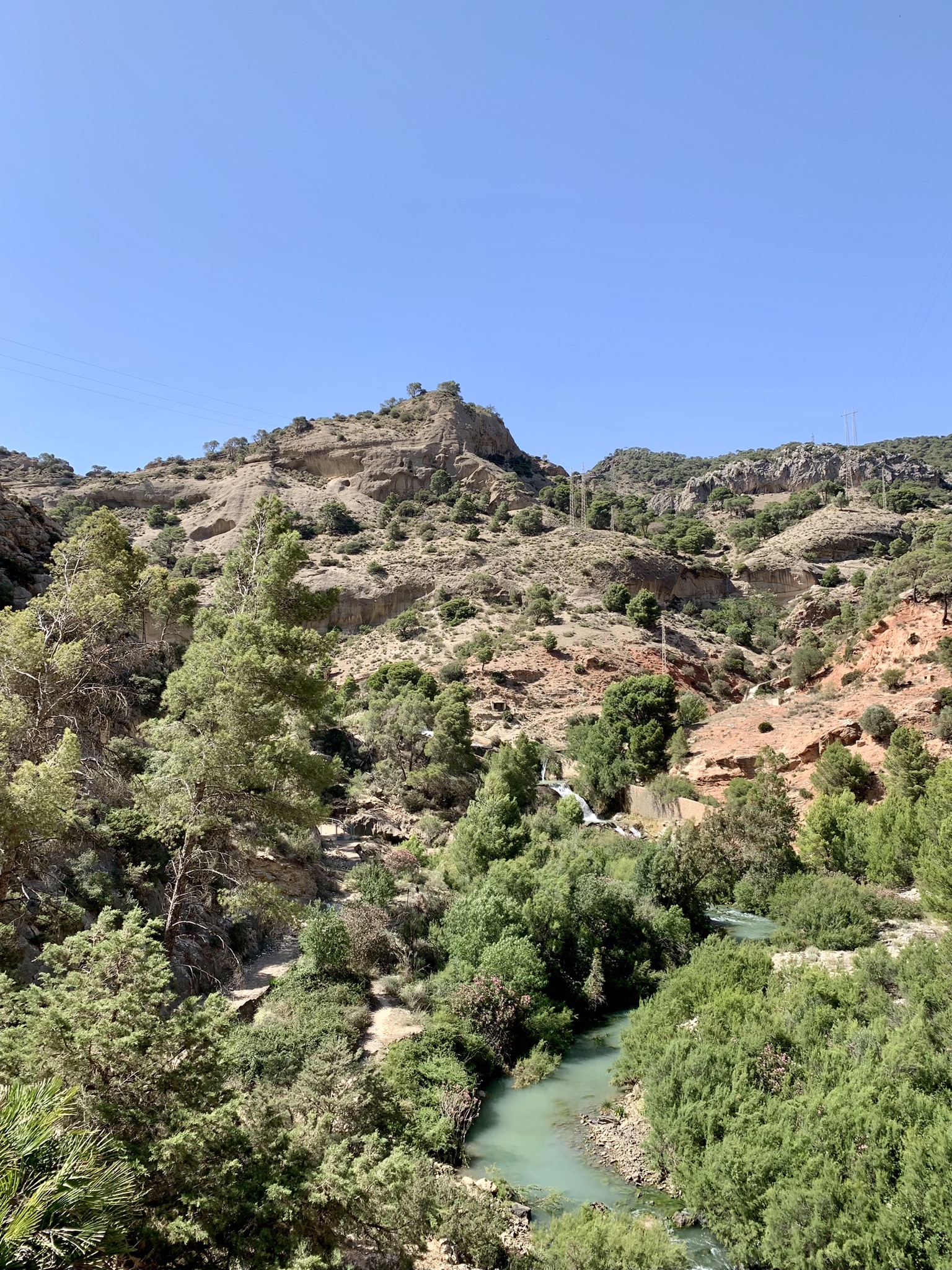

What items are not permitted on the Caminito del Rey?
For safety reasons the following are not allowed on the Caminito del Rey:
- Big backpacks
- Selfie sticks and tripods
- Drones
- Hiking poles
- Umbrellas
- Pets
- Smoking
Is the Caminito del Rey suitable for people with a fear of heights?
If you have a mild fear then you should be ok but if you suffer from vertigo then you should probably reconsider.
I’m not a fan of heights but, as you’ll have read, I was ok until the very end when I had to cross the bridge.
What wildlife can you see?
The Caminito del Rey is home to a lot of wildlife but you may need luck on your side to see much of it.
We saw some Iberian ibex but, if you’re lucky, you might also spot a fox, genet, or some wild boar.
If you look up you’re likely to spot vultures coasting on the thermals and may also spot an eagle or two. One species you can’t miss, particularly as you walk through the Gaitanejo gorge, are the pigeons which flit constantly between the cliff faces.
I hope you’ve enjoyed reading this – please feel free to drop a comment below if you have any questions.
Happy hiking!


Why not pin this for later and follow me on Facebook, Instagram and Twitter for more inspiration, photos and updates?
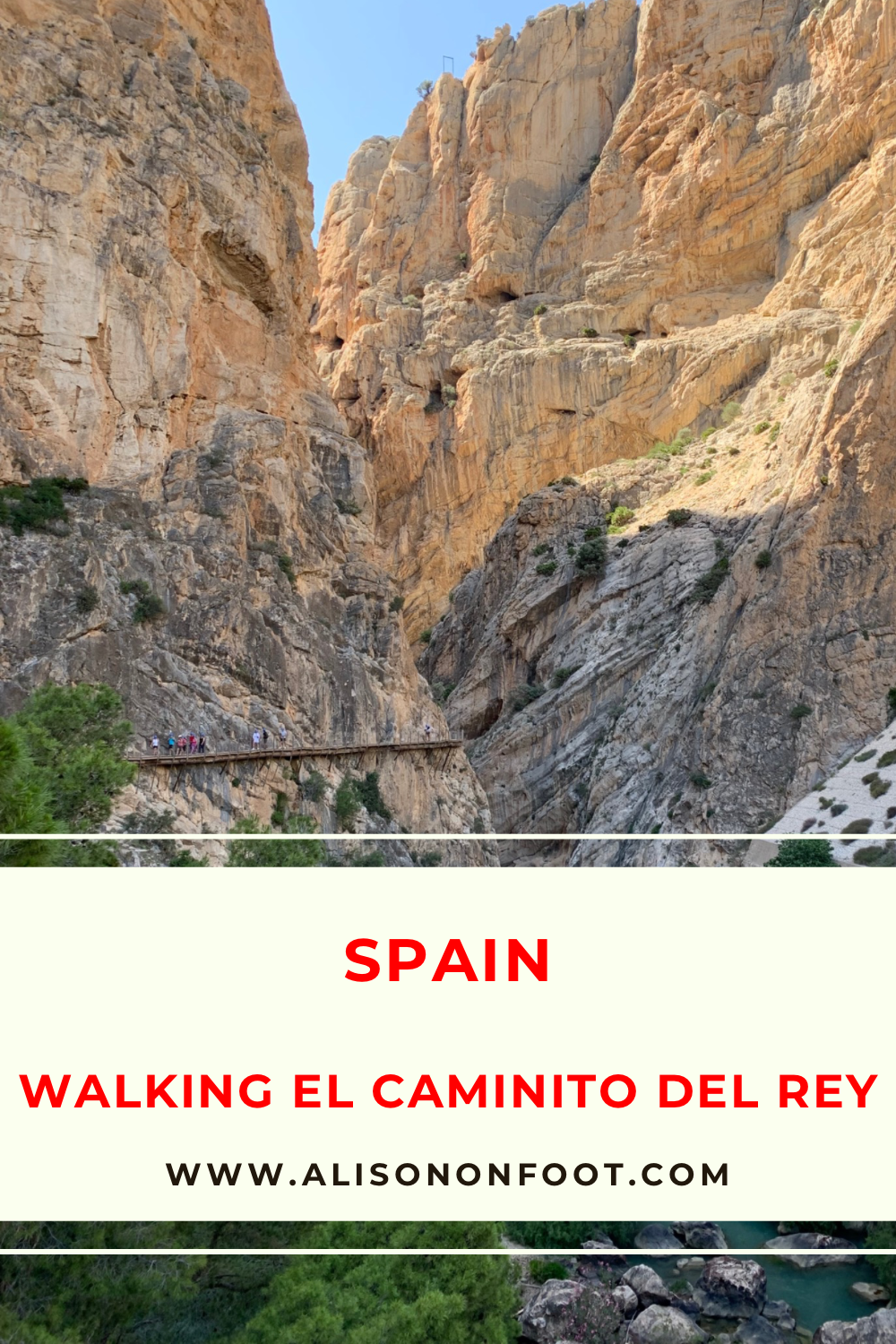



I’ve seen plenty of picture of this hike, and had decided that it wasn’t for me due to my own fear of heights. However, after reading this post, I think I can do it really without much problem. Thanks for all the detail and the photos. And it’s good to know that there is an easy train option from Malaga. I definitely plan on hiking it when we make it back over that way.
Glad you enjoyed reading Steven. It’s definitely doable as long as your fear of heights isn’t too extreme and I surprised myself with just how much I enjoyed it. It was really only the very last section I didn’t like but the guide on the bridge was great and obviously used to dealing with people who’ve got the fear! You won’t regret it and taking the train from Malaga is a lovely way to start and end the day.
That’s a fantastic looking place for a walk with all the dramatic scenery. A nice detailed post and the train information means would be possible for us.
It was absolutely stunning. I was starting to run out of superlatives when I was writing it! The train is a really good way to get there – not a long journey but a very scenic one.
Hi Alison, What an amazing adventure you had walking the Caminito del Rey! I was blown away by your photos and descriptions of the scenery and the history of the place. You gave me the impression that I was there with you. I have always wanted to visit this place, but I was a bit scared of the heights and the narrow paths. Your article gave me the confidence and motivation to give it a try.
Thank you so much for your lovely comments. You should definitely walk it if you get the chance – it’s honestly not as scary as it looks!
Great post, going to book now for April, thanks,
Do you have any posts on the Camino de Santiago ?
Thanks Michael. I hope you enjoy it!
I have lots of posts on the Portuguese Way of the Camino de Santiago as I walked it in 2022. There’ll be posts about the French way coming later this year as I’m walking part of that in May.
I’ve heard of the caminito del rey from Sonia and Wotjekt so I’m excited to have another blogger pal endorsing this hiking experience. Pictures look all insanely beautiful and adventurous, plus I like how accessible the hike is from Malaga. I would hate to have to rent a car to see it. The costs are reasonable, too. Thanks ever so much for sharing and compiling such a detailed and comprehensive guide on the Caminito del Rey hike. Since you are based in the area, do you think this is an experience you’d do again?
Carolin | Solo Travel Story
Thanks Carolin. I really appreciate your comments. I would absolutely do it again – it’s one of those experiences that will be different each time you do it. Next time I’d not bother with a guided tour so I’d spend longer there and, of course, I’d be well prepared for the hanging bridge at the end so hopefully wouldn’t be quite so scared!!;O)
Such lovely pictures! The views along the trail look fantastic! I am not sure ‘”safety helmets” scream “safe hike”, but haha oh well, it doesn’t look too bad! 🙂
Haha I see what you mean! It’s definitely safer than it used to be so that’s a positive in my book! ;o)
How tight was the tunnel path to get to the entrance?
It’s tall and wide enough to be able to walk through comfortably at least two abreast without having to stoop.
Hey, thanks for the informative post. I am wondering how you married up the train times with the entry ticket? Only the guided set entry times are now available. For example if a tour leaves at 12, I will need to factor in 1hr train journey plus 1hr 30min potential shuttle bus ride? So departing Malaga at 9am? Many thanks.
Hi Kate, glad you enjoyed it. I would suggest an earlier train just in case of any delays. It’s also worth considering that the shuttle buses might be busy so there could be a wait to get one. There’s not a great deal to see in El Chorro itself but there are a few nice places to have breakfast or a coffee while you waited for the shuttle bus. Hope you enjoy your trip!
Thanks for this post! So thorough, with information I saw nowhere else. I’m looking forward to doing this hike in September, should be very memorable.
Thanks Laurie, I’m glad you enjoyed reading it. Have a great time in September.
What a great article. Really gives you a detailed explanation. Just wondering about the steep narrow steps towards the end. How many would you say there are……… someone mentioned it was like 3 flights . One article said that for first timers, park at the visitors center, then take the shuttle bus….. does it leave here on the hour or half hour?. We are driving from Malaga and it seems like I will need at least two hours before the walk actually starts.
Thanks Lesley I really appreciate it. There are a few flights of steps at the end but with some level walking in between. If you look at the photo in the post just before the Stage Three section it’ll give you an idea of what they’re like.
The shuttle bus leaves every thirty minutes on the hour and half hour and you definitely need a few hours beforehand just in case the bus fills up and you have to wait for another. If you park at the Visitor’s Centre you’ll have to get the bus at the start and at the end but, if you park near El Kiosko restaurant, you’re closest to the entrance to the walk and you’ll only need to get the shuttle bus at the end back to your car.
I hope you enjoy the walk!